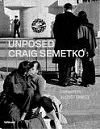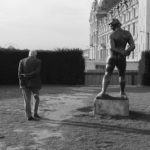A classic street shooter in the great tradition, Craig Semetko uses his Leica cameras to capture images that transcend the moment. Born and raised near Detroit, Michigan, Craig Semetko became a comedy writer and performer after college, inspired by his “very funny father” and his love for Peter Sellers, Richard Pryor, John Belushi and Bill Murray. In high school he was voted Class Clown and he developed his photographic eye by making short movies for his classes.
In 2008 Semetko’s work was featured along with work by famed photographer Henri Cartier-Bresson at the Open Shutter Gallery in Durango, Colorado. The exhibition was entitled, “Street Photography: From Classic to Contemporary – Henri Cartier-Bresson and Craig Semetko.” In 2009/2010 he mounted one-man shows at the Leica Galleries in Frankfurt, Germany, Salzburg, Austria and at the Leica headquarters in Solms, Germany. His work was also recently shown opposite renowned photojournalist Elliott Erwitt’s in the group exhibition “The Art of Photography Today” at the Camera Obscura gallery in Denver, Colorado. In June of last year he spoke on street photography at the International Center of Photography in New York City. He was the keynote speaker at the Leica Historical Society of America’s 2009 annual meeting in Seattle, Washington.
Here, in his heartfelt and illuminating words, he reveals the essence of his ongoing creative quest and his profound connection to Leica M cameras and lenses.
Q: What camera and equipment do you use?
A: I use both a Leica MP and an M9, primarily with the 35mm f/1.4 and 50mm Summilux lenses.
Q: Have you ever thought about acquiring additional lenses, especially something wider than 35mmm, such as a 28mm, 24mm, or 21mm and if so which particular lenses interest you most?
A: Actually, I own a 21mm f/2.8 Elmarit ASPH, a 28mm f/2 Summicron ASPH, a Tri-Elmar, a 75mm f/1.4 Summilux, and a 90mm Elmarit. I use them all, but the 35 and 50 are the ones that I travel with. I use the 75 for portraits, and the 21 is great for getting unusual perspectives. Of the 54 pictures in my book, “Unposed,” I think one is taken with a 90, two with a 28, two with a 21, and the rest were all shot with the 35 and 50.
Q: How would you describe your photography? What is your motivation or what are you trying to achieve in general terms with your photography?
A: I would describe my photography as humanistic — I like people and they seem to be my favorite subjects. I don’t know that I have a conscious motivation with my work. I just see something that amuses me or moves me or interests me and…“click.” I try not to think about it too much. Thinking constipates things.
Q: Were you a serious enthusiast before going pro? What made you decide to go pro?
A: Yes, I was a serious enthusiast for years. The transition to pro was sort of a natural progression. There wasn’t a specific moment when I decided to go pro. I started to show my work more beginning in 2007, and then in 2008 I co-exhibited with Cartier-Bresson at the Open Shutter Gallery in Colorado. The ball started rolling pretty quickly after that.
Q: Co-exhibiting with a legend like Henri Cartier-Bresson sounds sort of wonderful and terrifying at the same time. Did you have any such mixed emotions and what was the experience like?
A: To understand what that exhibition meant to me you have to understand what Cartier-Bresson means to me. He was instrumental in my buying a Leica and becoming a photographer. The day I went to buy a big zoom lens for street shooting, the salesman handed me a Leica booklet that featured an interview with Cartier-Bresson and some of his work. I was hooked instantaneously. I bought all of his books, pored over his pictures, and tried to internalize his philosophy. To me he was “The Man.” I spent eight years looking for my own “decisive moments” and then one day I get an email from a gallery asking me if I’d like to show my work alongside Henri Cartier-Bresson’s. I literally thought a friend had hacked my account and was screwing around with me. But a couple months later I was at an opening night party with 25 of HCB’s prints on one wall and 25 of mine on the other. It was wonderful, overwhelming, and extremely humbling. I choked up more than once.
Q: When did you first become interested in photography as a mode of expression, an art form, a profession?
A: I’ve been a comedy writer and performer for most of my adult life. I rarely took pictures — I didn’t even take a camera with me on vacation. But I had a corporate gig in March of 2000 that took me around the world, and I thought if ever there was a time to take a camera, that was it. While in China, I took a picture outside Shanghai of two peasant women transporting a load of brush up a river in a small dugout canoe. Until then, my job was to tell stories through performance – that picture showed me I could tell stories with a camera as well.
Q: How do you think being a professional comedy writer and performer has influenced the style, approach, or content of your photography?
A: My comedy background has given me a highly developed sense of the absurd and ironic. Consequently, I look for the funny. It’s my default setting. I often put myself in places where the odds of something odd happening are high – for instance, I live in Los Angeles. But just as often the strange finds me and then I get very focused. I may not take a shot for hours, but when something peculiar happens in front of me, I go into high gear. As Hunter Thompson said, “When the going gets weird, the weird turn pro.”
Thank you Craig!
-Leica Internet Team
To see more of Craig Semetko’s work, please visit his website: http://craigsemetko.com/.You can purchase Craig’s new book “Unposed” from publisher TeNeues.

Stay tuned for the second installment of our interview with Craig Semetko.

Comments (8)